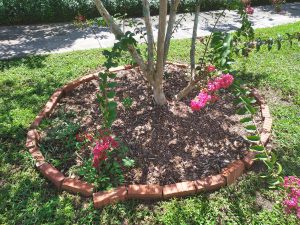Pesticides are an effective control for pests and diseases. On the other hand, when not using pesticides correctly these chemicals can affect the environment negatively.
What Composes the Environment?
The environment is composed of everything that surrounds us. This includes natural areas as well as indoor spaces and living spaces. The air, soil, water, plants, animals, humans, houses, restaurants, office buildings, schools, factories, and all that they contain are part of the environment.
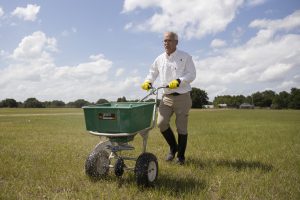
Sources of Contamination:
Pesticides are chemicals designed to kill specific organisms. Having that in mind, pesticide applicators must ask themselves 2 questions:
- Where is the pesticide going to be applied (What is the target)?
- How can this pesticide affect non-target organisms and sites?
These questions are important to avoid point contamination or non-point contamination. Point contamination is pollution from a distinct identifiable source; for example, pesticide spills from a storage facility. Non-point contamination is pollution where the origin is not from easily identifiable sources; for example, pesticide runoff, leaching, and drift from multiple landscape pesticide applicators.
To minimize these sources of contamination the most important action is to apply pesticides according to label instructions. The label is the law, and it will explain to the applicator what the target organisms it controls, where it can be applied, what are the rates of application, and what impacts can pose on the environment.

4 Characteristics of Pesticides
Pesticides have 4 characteristics that need to be understood to avoid contamination:
- Solubility: The ability of a pesticide to dissolve in water or another solvent. The more soluble the pesticide the more difficult it is to remove it from the solvent. The less soluble the more likely it is to move in surface runoff.
- Adsorption: The ability of a pesticide to bind itself to soil particles. A pesticide that adsorbs itself to soil particles is less likely to leach out into groundwater. Adsorption is lower in sandy soil with low organic matter, which means leaching is more likely in these types of soil.
- Persistence: The ability of a pesticide to remain present and active in its original form for an extended period. Nowadays we are using pesticides that breakdown in the environment relatively quickly compared to the past. Regardless, it is important to consult label instructions to understand for how long the pesticide you are using will be active.

Soils with high organic matter can reduce pesticide leaching. Photo Credit: Luis O. Rodriguez, UF/IFAS - Volatility: The tendency of a pesticide to turn into a gas or vapor. In general, higher temperatures will increase the change of volatilization although some pesticides have higher volatility than others.
Information about these characteristics can be found on the pesticide label and depending on these, the pesticide applicator will need to adjust their application procedures to minimize the risk of contamination.
What is Drift?
Pesticide drift can be defined as the unintentional movement of a pesticide from a target location to an untargeted location. A little drift is acceptable but an excessive amount of drift could be harmful to the environment and depending on the situation it could end in legal problems. There are 3 types of drift:
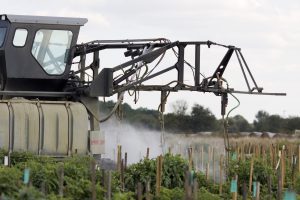
- Spray drift: This is the most common type of drift. It is the movement of a pesticide from the target location during a liquid application. To minimize spray drift, do not apply pesticides when there are bad weather conditions, increase the droplet size of the nozzles, and verify your equipment calibration.
- Vapor drift: This is the movement of a pesticide vapor from the target location. To minimize vapor drift avoid using highly volatile pesticides at high temperatures, avoid bad weather, and verify your equipment calibration.
- Particle drift: This is the movement of pesticide particles such as dust, granules, and pellets from the target location. To avoid particle drift, avoid bad weather, use reflector shields when needed, and verify your equipment calibration.
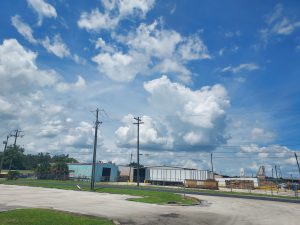
Drift Management
To minimize the impacts of drift in the environment follow these recommendations:
- Follow label instructions.
- Spray only when conditions are right; avoid bad weather events before and after the application.
- Select a boom height for your equipment that is effective but at the same time reduces the possibility of drift.
- Select a reasonable application speed.
- Use the right nozzle for the application (Bigger nozzle droplet size can reduce drift).
- Calibrate your equipment, accordingly, replace worn-down parts, and do not use faulty equipment.
- Use pesticides that are less volatile.
- Use drift-reduction agents.
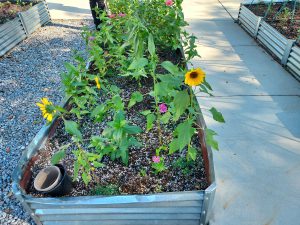
Sensitive Areas and Non-target Species Protection
Sensitive areas are places where living creatures can be affected by pesticides. This includes schools, playgrounds, parks, reserves, apiaries, farms, hospitals, and any other similar areas where wildlife and humans are present. To avoid possible problems in sensitive areas, many pesticide labels have special instructions on how to use them in sensitive areas. It is important to follow these instructions to avoid unnecessary risks and only use pesticides when needed.
If you know that the area of the application has a high population of pollinators follow these instructions:
- Notify nearby beekeepers before the application.
- If possible, apply the pesticides at night when pollinators are less active.
- Do not apply to attractive blooms.
- Avoid water contamination.
- Use pesticides only when needed.
Conclusion
Pesticides are necessary to control pests and diseases in farms, landscapes, and other places where these pests and diseases pose a threat to human health and economic issues. Regardless of their effectiveness, we need to understand the impacts they can cause when not using them according to label instructions. Understanding the characteristics of pesticides and creating a drift management program will help pesticide applicators minimize the negative impacts of pesticides on the environment.
For more information about pesticides in the environment access the following “Ask IFAS” publication:
PESTICIDE LABELING: ENVIRONMENTAL HAZARDS STATEMENTS
MINIMIZING HONEY BEE EXPOSURE TO PESTICIDES
University Of Florida is an Equal Opportunity Institution
 3
3
